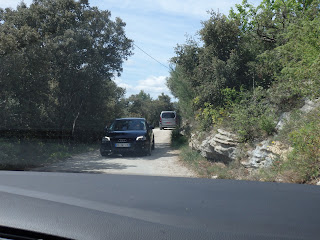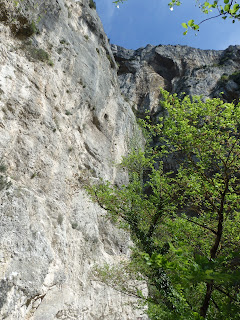We took all our warm things because the weather is blustery with the cold Mistral today and even if the sun is warm, the cold wind makes you shiver. It's not a day for sitting on a terrace for an ice cream, like yesterday. I rode with Alexandrine and Gérard and we followed Dave who is navigating with Clark today.
We started out early as the later in the day, the more difficult it is to find parking and the more people there are in the village. Since it's the last Sunday of Easter vacation, we expect crowds today.
First stop Gordes, a perched village. You can see why it is so named from the photos. It well deserves its most beautiful village designation.
 |
| Our view on the way in. The large building on top is the church. Behind it, seemingly smaller is the castle - which is 4 medieval stories tall. |
It's pretty steep in places and when we get to the top, we could feel the full effect of the wind. The tourist office is in the castle and all but Alexandrine and I tour the building which is now a modern art museum with lots of steps I wouldn't be able to climb (4 stories) and no reconstructed rooms to see.
 |
| looking up at the castle towers |
 |
| view of the castle from the east side |
 |
| view of castle from west side |
The view, however, is pretty good up top!
 |
| Gérard in teh 4th floor of the crenelated tower on the south end of the castle |
Alexandrine and I found a café and drink a café while we wait out of the wind for the others to finish their tour.
 |
| Alexandrine and I in café - it was warm in here. Photos on wall are WWII and prior of Gordes |
As in every village and town we visit, there is a memorial to the sons lost in WWI and WWII.
 |
| WWI & WWII memorial |
The streets (foot paths, really) of cobblestone head steeply down toward the church and the old part of town. But the church is under construction and we all agree that getting off this hill and out of the wind is a good idea.
We decided to look at Les Bories on our way out of town. The turn off, only a kilometre or so down the road is well marked, but the bories are nowhere near the main road. Rather they are down one of France's small two-lane roads that are only one lane wide.
 |
| Dave driving our Peugeot on the two way road |
 |
| He met another car and they just managed to shimmy past each other without falling off the road |
 |
| dry-stacked walls line both sides of the road to Les Bories. On top are vertically stacked stones. Some walls are a couple feet thick |
Les Bories is just a few kilometers away in distance, but seems centuries removed from the village life of Gordes. This is a rural village, completely self-sufficient by the labor of the hands of its inhabitants. Bories, dry-stacked stone rounded huts, have been a feature of the Provençal (and world-wide) landscape since as early as the bronze age. They dot fields as storage sheds and shelters for animals like sheep and oxen and shepherds caught in the weather.
 |
| Judy and Lynn at Les Bories |
In a land with little wood for building houses and stones that had to be moved in order to cultivate the land, making walls and huts was a practical solution to both problems. The artistic look of these artisanal creations is striking.
 |
This village has 30 of these dry-stacked (built without mortar) buildings of various sizes housing various village activities - homes, storage sheds, stables for sheep, pigs, chickens and other farm animals, as well as manufacturing facilities like tanning or silk-worm growing.
Of course there is a community bakery.
 |
| Bake oven at Les Bories was open to the elements. It would be cold in the winter me-thinks. Even with a fire going. |
It is thought that this particular collection of bories was built, or at least remodeled, in the 19th century and was abandoned sometime in the latter part of that century.
It was purchased and, over 10 years, restored as a national historic monument in 1977. There is a strong contrast between what life must have been like in Les Bories compared to the village of Gordes just up the hill.
 |
| We learned that they do get snow on the grown (a dusting), but in good weather, the view is magnificent |
The skill that must have been needed to build these buildings so they had space inside and yet did not collapse on themselves! And the only tools used seemed to be a hammer and a primitive plumb bob (fil à plomb) to be able to determine the vertical. Each layer of stone has to be carefully chosen, trimmed and placed. Even a small hut might contain more than 100,000 stones and weigh tons.
 |
| Dave outside a borie house |
Near the car in the parking lot, Gérard found a couple of flat stones that would work for seats for our picnic. Making short work of our sandwiches and fruit, we headed to our next adventure: l'Abbaye de Sénanque.
 |
| lunch at Les Bories |
This abbey is on Judy's list (along with buying lavender) because of this well known and much copied photo of the abbey and its lavender fields.
 |
| a stock photo of the abbey at Sénanque with lavender growing |
This is what it looks like today:
 |
| The lavender has been replanted and the baby plants will not produce the color of the above photo this year |
The drive to its location in the valley between two massive hills of rock is indescribable. The roads cling to the steep sides of the cliff walls as we dropped farther and farther into a long narrow valley (no switchbacks here) at the bottom of which sits the abbey and its wealth of lavender fields, the proceeds of which help support the Cistercian monks who live and work here. Another form of income comes from other agricultural products like honey and from offering retreats at the abbey.
 |
| looking up from the abbey grounds - The road we drove can be seen as a strip of grey near the top of the cliff face |
 |
| the abbey sits in a narrow valley with towering cliff faces on either side |
 |
| these columns attracted my attention |
 |
| the monks' former dormitory - they all slept on piles of hay on the floor - look below to see their schedule - their day started at 2 am. Everything was regulated by the church bells. |
 |
| Some of the damage that can be seen in the monks' dormitory. The stones are shifting, some are falling, and some areas are in danger of collapse |
 |
| the cloister |
 |
| Lynn and Alexandrine in the cloister |
This abbey continues its work today and the Cistercian monks continue silently to offer their lives to prayer (7 times per day, including mass) and service.
The drive out on the other side of the valley was just as hair-raisingly close to the edge of the cliff as was our drive down. We headed to our last stop of the day, Fontaine de Vaucluse.
 |
| once a pull off was found near the top of the cliff, the crew got out to take photos looking back at Senanque |
 |
| Fontaine de Vaucluse. The Sorgue is large and fast here. The town is full of tourist restaurants and gift shops. The source of the Sorgue is the mountain in the center of the photo |
The feature of this town is tourism
and a rather rugged path up the side of the Sorgue so folks could discover the source of the stream. While I didn't make it all the way to the top, my companions thought the very "start" of the river was a bit of a disappointment.
There is a large blue pool where the sheer cliff-like rocks finally stop any further ascent. But no evidence of springs (which must be there, just under the pool of water).
 |
| the cliff face at the source |
 |
| the source - there's a spring gushing into here somewhere |
What we all found more interesting is a bit further down the path where the water roars into the river from under several rocks at once. The source is in the eye of the beholder, it seems.
 |
| what we would prefer to call the source - water gushes out of the rocks at high velocity (it is spring, of course) from the rocks at the bottom of this photo |
 |
| a bit further downstream |
The walk up (or down) did provide multiple places to order an ice cream cone for the trek.
 |
| Would you buy ice cream from a guy whose stand featured this inviting statue? |
Once back down, we walked to the other side of the river to find the Petrarch museum.
 |
| Petrarch museum |
 |
| Janis and Clark in park behind the museum. |
This Italian poet has a close connection with the city. Since Alexandrine was a French literature teacher, and since Petrarch is Italian like Alexandrine, this museum has a large draw on her heart. She and Gérard duck into the museum for a half hour while we go find a glass of wine at one of the many riverside cafés.
 |
| One of the many options for cafés hanging out over the river. We chose this one for its sun |
While watching the river from our vantage point, 3 teen-age boys came tubing down the river to the foot of the bridge just below us and climbed out. Since we were all bundled against the wind and seeking protected sunny spots to get warm, our eyes nearly bugged out of our heads at the sight and we felt instantly colder. Kids! Same everywhere.
Wine finished, and sun waning, we walked down to our car, parked just below the city. This time Gérard will lead as they have chosen tonight's restaurant in L'Isle-Sur-Sorgue. After a couple mis-turns, we arrived at our restaurant L'iDisle. This is a white table cloth restaurant with a very welcoming and cheerful wait staff. We all ordered Kir (white wine and cassis) as an apératif, then a menu of plat + dessert.
I ordered the cabillaud (mild white fish) on a bed of quinoa with tomato coulis (syrup).
For dessert, Judy, Clark and I ordered a chocolate/raspberry confection while Gérard ordered the baba-au-rhum and Janis and Dave ordered the cheese plate.
We drank Vin de Ventoux. Dinner conversation was so much fun as we got to ask questions on a range of questions we've been saving up. Why do ???? What do you think????
Again we didn't get home until almost 10 pm. So no long conversations but good long sleep.







No comments:
Post a Comment